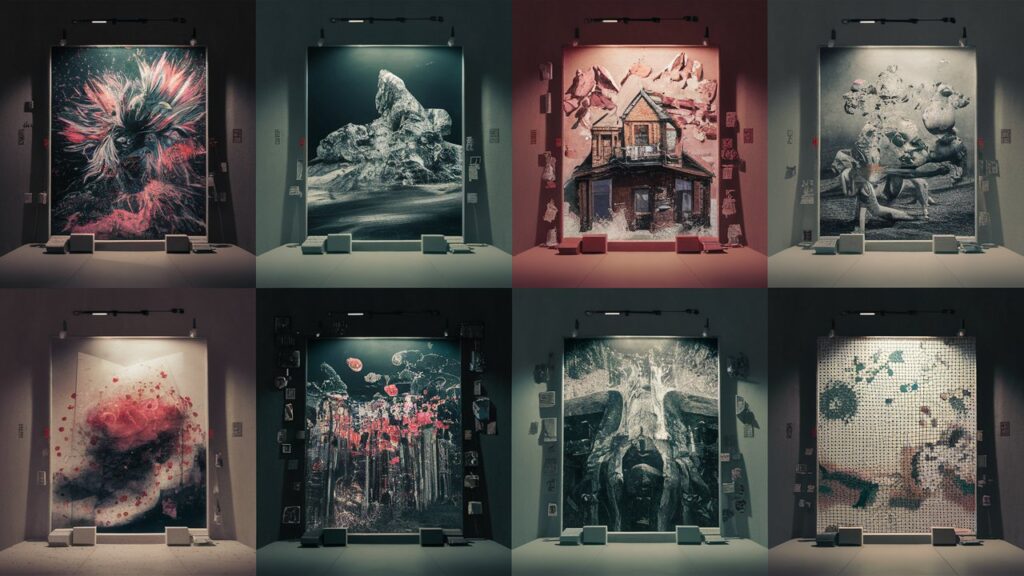In the world of design and architecture, traditional rendering techniques have long been the cornerstone of visualizing concepts. From intricate line drawings to meticulously crafted 3D models, these methods have served as the bridge between imagination and tangible form. However, what if there was a universe of innovative alternatives waiting to be explored?
A realm where watercolors dance with light, collages unveil hidden narratives, and minimalist strokes speak volumes. Welcome to a journey where creativity knows no bounds — welcome to “8 Creative Alternatives to Traditional Rendering Techniques.”
As we immerse ourselves in this exploration of possibilities, it becomes evident that breaking away from convention is not just about rebellion; it’s about unlocking untapped potential. The importance of delving into alternative rendering techniques lies in the promise of infusing a unique touch into each design, embarking on an innovative path less traveled.
Imagine a canvas where mixed media brings dreams to life or where nature’s whispers guide architectural marvels into existence. Each stroke, each pixel holds the power to transform visions into realities beyond the confines of tradition. So why settle for the ordinary when the extraordinary beckons us towards uncharted realms of creativity?
Join us on this captivating odyssey as we navigate through a tapestry of watercolors, dive deep into digital realms brimming with animation, and sculpt our ideas into tangible forms.
Let curiosity be our compass, diversity our map — for in exploring these creative alternatives, we not only redefine visualization but empower ourselves with newfound tools to shape the future of design and architecture. Dare to dream differently; dare to render beyond boundaries — for within these alternatives lie the sparks that ignite innovation and breathe life into imagination’s wildest flights.
Watercolor as a Rendering Alternative.
Dipping brushes into a palette of vibrant hues and watching watercolors flow effortlessly across the canvas is not just an art form but an innovative approach to architectural rendering. Watercolor techniques offer architects, interior designers, and artists a unique way to infuse their designs with fluidity and character.
By embracing watercolors in rendering, creators can add a touch of whimsy and emotional depth to their architectural concepts, steering away from the rigidity often associated with traditional rendering methods.
One of the remarkable advantages of using watercolor for rendering lies in its ability to instill an artistic flair into otherwise technical designs. With watercolors, architects can create ethereal landscapes that seem to dance on paper, inviting viewers to immerse themselves in a world where buildings come alive with color and emotion.
The transparency and blending properties of watercolors allow for organic transitions between shades, giving renderings a softness and warmth that may be lacking in more rigid digital representations. This alternative approach not only breaks the mold of conventional rendering techniques but also empowers designers to infuse their projects with a more human touch.
Imagine a residential project brought to life through delicate washes of color that evoke feelings of serenity and comfort or envision a public space rendered in bold, expressive strokes that convey vitality and energy.
Watercolor rendering offers endless possibilities for experimentation and creativity, allowing designers to transcend the boundaries of traditional architecture visualization. By incorporating this versatile medium into their toolkit, professionals can unlock new dimensions in design expression and captivate audiences with visually stunning representations infused with personality and charm.
Mixed Media Exploration: Elevating Design Renderings through Diverse Techniques.
In the realm of design and architecture, embracing a mixed media approach can breathe new life into traditional rendering techniques. By intertwining pastels, markers, and digital tools, designers unlock a realm of possibilities that go beyond the constraints of singular mediums.
Picture this: the soft texture of pastels blending seamlessly with the precise lines of markers, all layered with the digital finesse of technology – a symphony of creativity at play. This blend not only adds depth and richness to renderings but also introduces a multi-dimensional allure that captivates the eye and evokes emotions in viewers.
The beauty of mixed media exploration lies in its ability to transcend boundaries and create dynamic visual narratives. Imagine a design rendering where textured pastel strokes mimic the warmth of sunlight filtering through lush foliage while crisp marker details delineate modern architectural structures against this organic backdrop.
This juxtaposition fuses nature-inspired elements with contemporary designs, offering a unique fusion that resonates with authenticity. By combining different mediums thoughtfully, designers can infuse their renderings with layers of meaning and intricacy that spark curiosity and invite viewers into a world where imagination knows no bounds.
Moreover, exploring diverse techniques not only enhances the aesthetic appeal but also amplifies the communicative power of design renderings. Traditional approaches often excel in precision or artistic flair individually; however, by merging various mediums, designers achieve a harmonious balance between technical accuracy and expressive storytelling.
Think about presenting a concept where digital overlays enhance hand-drawn sketches or where vibrant marker accents highlight key features in an otherwise subdued palette – each element working together to convey a cohesive vision that speaks volumes beyond words.
In this blend of mediums lies the magic – an alchemy that transforms design renderings into immersive experiences that transcend conventional boundaries.
Collage Creation for Design Rendering.
When it comes to breathing life into architectural renderings, sometimes all it takes is a playful blend of textures, colors, and forms. Collage art offers a refreshing departure from the norm by infusing designs with a unique aesthetic that sparks curiosity and invites viewers to explore beyond conventional boundaries.
Imagine juxtaposing photographs of urban landscapes with abstract shapes or incorporating snippets of textures from nature to create a tapestry of design possibilities. Collages not only showcase creativity but also provide architects and designers with an innovative platform to experiment with unconventional elements.
The versatility of collage art extends far beyond mere cutting and pasting – it’s about layering various elements strategically to evoke specific emotions or tell compelling visual narratives. For instance, consider how a collage combining vintage blueprints with modern 3D renderings can offer a time-travel experience through architectural history in a single frame.
By embracing collage creation as a design rendering alternative, professionals in the creative realm can push boundaries and craft visual stories that resonate on multiple levels.
In the realm of architectural renderings, collages breathe fresh air into static images by infusing them with dynamic energy and depth. Whether using traditional cut-and-paste techniques or exploring digital collage tools, designers can break free from the constraints of traditional rendering methods to unleash their imagination fully.
As you embark on your journey into the world of design rendering alternatives, consider how collages can serve as windows into imaginative realms where creativity knows no bounds – where walls speak stories, and textures dance in harmony with lines, creating an ever-evolving canvas of endless possibilities.
Digital Animation for Dynamic Visualization.
In a world where static images often dominate design presentations, digital animation emerges as a captivating alternative that breathes life into architectural renderings. By harnessing the power of advanced software tools, designers can now create moving and dynamic visuals that offer a comprehensive view of spatial designs like never before.
Imagine walking through a virtual representation of a space, experiencing its flow, scale, and ambiance in real-time—a far cry from traditional static renderings.
One notable advantage of digital animation in design presentations is its ability to convey the essence of a project effectively.

Through animated sequences, viewers can appreciate how spaces evolve over time, capturing transitions between day and night lighting conditions or showcasing how natural elements interact with built structures.
This level of immersion not only engages the audience but also provides a deeper understanding of the designer’s vision, making complex concepts more accessible and compelling.
For instance, imagine an architectural proposal where the shifting shadows cast by dynamic light sources are intricately choreographed to showcase the play of natural illumination throughout the day.
Through digital animation, designers can emphasize these nuances, creating visual narratives that go beyond static renders. This approach not only highlights the beauty of the design but also communicates its functionality and sensitivity to environmental factors—a crucial aspect in contemporary architectural practice.
By embracing digital animation as a rendering alternative, designers open up new possibilities for storytelling and creative expression in their projects.
As technology continues to advance and tools become more accessible, incorporating dynamic visualization techniques into design presentations will likely become standard practice for architects and designers looking to push boundaries and engage audiences in innovative ways.
Sculptural Models for Concept Development.
In the realm of architectural projects, where imagination meets reality, sculptural models stand out as invaluable tools in the creative process. Unlike digital renderings that exist purely in the virtual realm, physical models offer a tactile experience that engages multiple senses.
Imagine architects huddled around a meticulously crafted miniature representation of their vision, running their fingers over details and exploring different perspectives. These models serve as tangible manifestations of ideas, providing a depth of understanding that goes beyond what screens can convey.
Their physical presence aids not only in better comprehending spatial relationships but also in refining design nuances that might otherwise be overlooked.
Take the case of renowned architect Frank Gehry, known for his groundbreaking designs that challenge traditional norms. Gehry’s iconic Guggenheim Museum Bilbao was famously conceptualized using sculptural models that helped translate his organic forms into concrete structures.

By working hands-on with materials to shape his ideas, Gehry was able to push boundaries and bring to life architectural marvels that defy convention. This example showcases how sculptural models can inspire architects to think beyond two-dimensional drawings and venture into uncharted territories of design exploration.
Indeed, the journey from concept to creation often requires more than just digital simulations—it demands a tactile understanding rooted in physicality. Sculptural models bridge this gap by offering a holistic view of architectural concepts, fostering creativity through touch and visual immersion.
Architects who incorporate these tangible representations into their workflow find themselves delving deeper into the essence of their designs, allowing for informed decisions and innovative solutions that shape the built environment in remarkable ways.
Light and Shadow Play in Renderings.
When it comes to design renderings, the interplay of light and shadow can transform a flat concept into a vivid, dynamic visualization that captivates the viewer. By strategically using light sources, designers can create depth, drama, and realistic atmospheres that breathe life into their projects.
Imagine a minimalist architectural drawing suddenly coming alive with the warmth of a setting sun casting dramatic shadows across its façade, highlighting textures and contours that were once overlooked. This technique not only adds visual interest but also helps convey the mood and ambiance intended for the space.
One effective method is to experiment with different angles and intensities of light to see how they interact with various surfaces and materials. For instance, playing with soft diffused lighting versus sharp directional light can evoke contrasting emotions within a design—think of how a tranquil spa setting differs from an energetic workspace simply by adjusting the lighting effects.
By understanding the nuances of light manipulation, designers can sculpt spaces on paper or screen that feel almost tangible, inviting viewers to step into their envisioned worlds.
Moreover, embracing light and shadow play in renderings allows for limitless creativity in storytelling through design. Picture a cozy café scene where dappled sunlight filters through lush greenery onto rustic wooden tables or a sleek office interior bathed in cool artificial light creating an atmosphere of modern sophistication.
Whether aiming for photorealism or stylized interpretations, mastering the art of manipulating light in renderings empowers designers to craft compelling narratives within their visual presentations while breathing life into static illustrations.
Minimalist Approach to Rendering Techniques.
In a world often cluttered with excess, the minimalist approach to rendering techniques stands out for its emphasis on simplicity and clarity. By stripping away unnecessary details, minimalist renderings focus on conveying essential design elements in a clean and straightforward manner.
This style not only offers a breath of fresh air from busy visuals but also allows viewers to appreciate the beauty in simplicity. Embracing minimalist techniques empowers designers to communicate their ideas effectively without overwhelming the audience with superfluous information.
One of the key benefits of adopting a minimalist rendering style is its ability to highlight crucial design elements that might get lost in complex compositions.
By utilizing negative space and concise linework, minimalist renderings provide a sense of calm and coherence, making it easier for viewers to grasp the core concept of a design at first glance.
In architecture and interior design, this approach can help streamline communication between designers, clients, and stakeholders by focusing on what truly matters, fostering clearer discussions and decision-making processes.
Imagine an architectural rendering that captures the essence of a space with just a few well-placed lines and subtle shading – emphasizing the play of light and shadow against crisp edges.
The minimalism in such renderings not only conveys a sense of elegance but also invites viewers to engage with the design on a deeper level, encouraging them to appreciate the thoughtfulness behind each element presented.
By exploring the realm of minimalist rendering techniques, designers can unlock new possibilities for enhancing visual storytelling while maintaining an uncluttered aesthetic that speaks volumes in simplicity.
Nature-Inspired Rendering Concepts.
In a world where technology often dominates design processes, drawing inspiration from nature can breathe fresh life into architectural renderings. Incorporating natural elements such as textures, colors, and patterns can add depth and emotional resonance to designs.
Imagine infusing the serene hues of a forest canopy into a building’s facade or mirroring the intricate fractal patterns of a seashell in interior layouts. By embracing the organic beauty of the world around us, designers can create spaces that resonate with a sense of harmony and connection.
Nature-inspired rendering concepts invite users to explore beyond conventional aesthetics and immerse themselves in the splendid diversity of the natural world. From rocky textures mimicking cliff faces to soft, earthy tones reminiscent of sandy shores, each element drawn from nature tells a unique story within architectural illustrations.
By paying homage to the intricate design solutions found in ecosystems, architects and designers can infuse their creations with a sense of timeless elegance and sustainability.
By incorporating nature-inspired themes into design renderings, creators have the opportunity to not only showcase their artistic skills but also promote environmental consciousness. Utilizing sustainable materials, biophilic design principles, and biomimicry techniques further solidifies the bond between architecture and nature.
This approach not only fosters creativity but also encourages users to rethink traditional rendering methods by aligning them with the beauty and resilience of natural systems. As we continue to push boundaries in design, let nature be our guide towards innovative and harmonious creations that stand the test of time.
The Future of Creative Rendering.
As the world of design and architecture continues to push boundaries and embrace innovation, the realm of rendering techniques stands at an exciting crossroads. With traditional methods serving as reliable foundations, the emergence of alternative approaches opens up a universe of possibilities for architects, interior designers, graphic artists, and creatives alike.
By exploring unconventional rendering techniques like watercolor artistry, mixed media blends, digital animation marvels, sculptural model intricacies, light-play dynamics, minimalist expressions, collage adventurism, and nature-inspired aesthetics, a new era in visualization unfolds.
In this vibrant landscape where creativity knows no bounds, the future of rendering lies in the hands of those willing to experiment and challenge norms. Encouraging continued exploration fuels not just individual development but also collective progress within the design community.
Let’s embark on this journey with open minds and resourceful spirits, embracing diverse perspectives to carve out fresh pathways in creative expression. Together, let us shape a tomorrow where imagination reigns supreme and traditional rendering finds its perfect dance partner in a world brimming with alternatives waiting to be discovered and celebrated.
I am commitment to crafting compelling narratives and delivering insightful content continues to inspire and inform readers across various platforms. Explore her articles on AlternativesZone.com and FactAfterFact.com to experience a rich tapestry of knowledge and discovery. Here I Analyze and Test the products and services together with my team before we recommend them to our users. Nice Reading Here!











